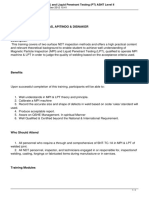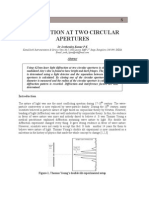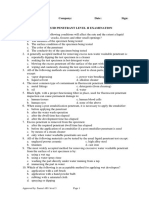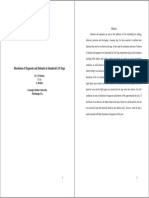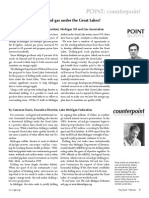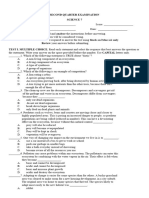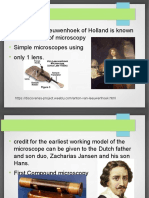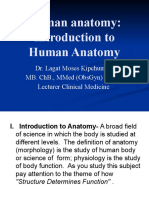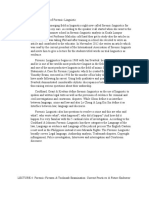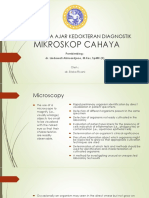Visual Inspection Modules
Visual Inspection Modules
Uploaded by
Agustine SetiawanCopyright:
Available Formats
Visual Inspection Modules
Visual Inspection Modules
Uploaded by
Agustine SetiawanOriginal Description:
Copyright
Available Formats
Share this document
Did you find this document useful?
Is this content inappropriate?
Copyright:
Available Formats
Visual Inspection Modules
Visual Inspection Modules
Uploaded by
Agustine SetiawanCopyright:
Available Formats
On Line Assessment Questions
Visual Testing Module 1
1. What term is used to decribe the emission of visible light which has a longer wave length than the incident radiation upon a body?
Photo Emission
Conduction
Fluoresecence
Luminosity
2. If the focus of an object focuses beyond the retina of a specific inspector, the inspector is said to have what type of vision?
Long sight
Short sight
Hypermetropia
20/20 vision
Long sight and Hypermetropia
3. From what minimum distance are far vision examinations carried out?
1 metre
30 feet
15 feet
6 metres
4. Which of the following colour vision deficiencies relates to green lacking
Protanopia
Deuetanopia
Trainopia
Tetratanopia
5. How far from the retina would the ideal eyeglass plane be?
17 mm
30 mm
21 mm
10 mm
6. What is the name given to ultraviolet radiation below 185 nm which is absorbed by air?
Vacuum
Non-existent
Short-wave
Electrolux
7. Which of the following most closely a grey body by exhibiting very nearly uniform emissuity?
Electric arc from TIG gun
A carbon filament in the visible region
Tungsten filament
Xenon short arc search light
8. What is the maximum angle from normal for acrrying out visual inspection?
http://www.lavender-ndt.co.uk/onlinelearning/index.asp
Page 1
On Line Assessment Questions
30 degrees
45 degrees
60 degrees
80 degrees
9. As the human eye becomes older which region of wavelength becomes increasingly more absorbed?
Blue
Green
Yellow
Red
10. What term is used to determine acuity measurements with a moving target?
Reserve vision acuity
Saccadic movement
Moving vision acuity
Kinetic vision acuity
11. Which colours are recommended in particluar for the work areas in which high noise levels and heavy physical exertion are
common?
Yellow
Blue
Orange
Red
12. Which of the following will reduce the glare from a light source?
Reduce the angle between light source and eye
Increase the light source
Reduce the background light around the glare source
Increase the angle between light source and eye
Reduce the background light around the glare source and increase the angle between light source and eye
None of the above reduces glare
13. What is the velocity of all fomrs of radient energy travelling in a vacuum?
299793 miles per second
3 x 106 metres per second
299793 kilometres per second
186282 kilometres per second
14. When using direct visual examination what size black line on an 18 percent neutral grey flat uniform background is usually
considered acceptance for a single line detection test?
750 microns
1000 microns
30 mil
50 mil
750 microns and 30 mil
15. Dirt on the surface of an item to be visually inspected can cause which of the following?
http://www.lavender-ndt.co.uk/onlinelearning/index.asp
Page 2
On Line Assessment Questions
Mask actual flaws
Obstruct Vision
Create false indications
Mask actual flaws and create false indications
Any of the above
16. When viewing a test surface from around 300 mm what is the best resolution of two objects on that surface which can be expected?
0.18 mm
0.09 mm
0.007 inch
0.27 inch
17. Generally what is the minimum white light intensity which should be used for critical examinations to detect fine details?
1000 lux
300 ftc
500 lux
150 ftc
18. Which of the following would be a correct definition of the nanometer?
10 x 10-9 meters
1 x 10-8 meters
10 x 10-10 meters
10 x 10-8 meters
19. Which of the following laws state that light flux striking a surface at angles other than normal is distributed over a greater area?
Lambert cosine law
Inverse square law
Cosine cubed law
Boyles law
20. Which of the following equations shows the lambert cosine law?
E = (I cos3 theta) / a2
E = I / d2
E = (I / d2) cos theta
E = (I2 / d) cos theta
Visual Testing Module 2
1. A Goniometer is a type of which of the following measuring devices?
Radiometer
Photometer
Refelectometer
Photomultiplier Tube
2. An electron microscope can be used to study structures down to a sensitivity of which of the following?
http://www.lavender-ndt.co.uk/onlinelearning/index.asp
Page 3
On Line Assessment Questions
Wavelength of visible light
10 angstroms
Wave length of infra red radiation
Wave length of uv-c radiation
3. What type of magnifier lens is housed in a simple surface comparator?
Triplet x 50
Doublet x 10
Doublet x 3.5
Triplet x 10
4. Which type of microscope uses the wavelength light as a unit of measure for surface contours and characteristics?
Interference microscope
Polarizing microscope
Phase contrast microscope
Metallographic wide field microscope
5. The fibres which are used in the image guide of a videoboroscope need to be kept in which of the following bundles?
Incoherent bundle 30 microns diameter
Coherent bundle 30 microns diameter
Coherent bundle 9 microns diameter
Incoherent bundle 9 microns diameter
6. The contrast rings which are attached to the electrical cord on a rigid boroscope serve which of the following purposes?
Viewing at 90 degrees to the forward direction
360 degrees rotation of the scope
Greater depth of field
Help hold the lens system rigid
7. For what purposes are neutral density filters used?
Transmission of electromagnetic waves below a set threshold
To block out radiation except for visible wavelength
Transmission of electromagnetic waves above a set threshold
To attenuate a light level from a source which is difficult to control
8. Which of the following filter types smooths abrupt transitions in an image to give a better picture?
Low pass spatial filter
High pass spatial filter
Media spatial filter
Neutral density filter
9. The topography of a fracture surface can be replicated and analysed using cellulose acetate tape with a transition electron
microscope up to what maximum magnification?
10000 x
50000 x
500 x
25000 x
http://www.lavender-ndt.co.uk/onlinelearning/index.asp
Page 4
On Line Assessment Questions
10. Which of the following acids which could be used to etch the surface of metals need to be contained within inert plastic containers?
Hydrochloric acid
Suplhuric acid
Nitric acid
All of the above
11. Which of the following detection devices works on the principle that change in resistance of the cell can be detected?
Photo emissive
Charged coupled device
Photo conductive
Photo voltaic
12. Which of the following films would require the least light?
400 A.S.A.
1000 A.S.A.
200 A.S.A.
100 A.S.A.
13. Which of the following could be measured with a cambridge weld guage?
Excessive re-inforcement
Weld preparation angle
Undercut
All of the above
Excessive re-inforcement and Undercut only
14. Which of the following would calculate the theoretical throat?
Leg length x 1.41
Leg length x 0.707
Leg length / 1.14
Leg length / 0.707
15. When using light emitting diodes on a video borocsope to produce a black and whit image, which colour is most likely to be used
due to response and intensity?
Blue
Yellow
Red
Green
16. Which of the following cameras would be the preferred choice for operation within a high radiation environment?
Charge couple device
Vidicon tube
Orthicon tube
Metal oxide semiconductor
17. Which of the following replicating materials would be best used to produce an impression of a relatively rough surface?
Cellulose acetate
Clay
http://www.lavender-ndt.co.uk/onlinelearning/index.asp
Page 5
On Line Assessment Questions
Silicone rubber
All could be used
18. What is the replica called which is made from the first cast of an impression such as footprint?
Single stage
Second stage
Positive
Negative
Single stage and second stage
Positive and Negative
19. If a replica made from cellulose acetate is to be viewed under a scanning electron microscope with which of the following materials
are the replicas coated to prevent electron charging?
Nickel
Cobalt
Gold
Iron
Nickel and Cobalt
20. In which of the following forms are temperature indicatiing materials available?
Pellets
Crayon stick
Organic liquids
All forms above are available
> Check Your Answers
Visual Testing Module 3
Not Available when donwloaded
http://www.lavender-ndt.co.uk/onlinelearning/index.asp
Page 6
You might also like
- Addison Wesley Science 10 Unit C SolutionsDocument22 pagesAddison Wesley Science 10 Unit C Solutionselty Tan100% (1)
- PT - Level 2 - S - 002 - Revised by RVMDocument4 pagesPT - Level 2 - S - 002 - Revised by RVMkingstonNo ratings yet
- Magnetic Particle Testing MT and Liquid Penetrant Testing PT Asnt Level IIDocument4 pagesMagnetic Particle Testing MT and Liquid Penetrant Testing PT Asnt Level IIomenNo ratings yet
- Liquid Penetrant Testing Module 3Document5 pagesLiquid Penetrant Testing Module 3mujjamilNo ratings yet
- GenZooLab Activities - MODULE 1Document5 pagesGenZooLab Activities - MODULE 1MikaylaNo ratings yet
- Diffraction at Two Circular AperturesDocument10 pagesDiffraction at Two Circular AperturesReddyvari VenugopalNo ratings yet
- Ultrasonic Testing Module 3Document6 pagesUltrasonic Testing Module 3mujjamilNo ratings yet
- Understanding Ultrasonic Transducers: Transducer CharacteristicsDocument1 pageUnderstanding Ultrasonic Transducers: Transducer CharacteristicsLuis Edward Quino OrdóñezNo ratings yet
- DGS DGS MethodDocument6 pagesDGS DGS MethodAlzaki AbdullahNo ratings yet
- PAUT CalibrationDocument10 pagesPAUT Calibrationfikril shaharudinNo ratings yet
- Profile RadiogarphyDocument24 pagesProfile RadiogarphySantosh Kumar100% (1)
- High Temperature Ultrasonic ScanningDocument7 pagesHigh Temperature Ultrasonic ScanningscribdmustaphaNo ratings yet
- Ultrasonics Examination Part 3Document3 pagesUltrasonics Examination Part 3JlkKumarNo ratings yet
- PCN UT Course in Trichy, PCN RTFI Training in Trichy, PCN PT, MT, Eddy Current Courses in Trichy - TIWDocument4 pagesPCN UT Course in Trichy, PCN RTFI Training in Trichy, PCN PT, MT, Eddy Current Courses in Trichy - TIWagniva datta100% (2)
- QZ EqDocument6 pagesQZ Eqgalati12345100% (1)
- LPTDocument22 pagesLPTPratik SalveNo ratings yet
- Eddy Current Inspection: UNIT-5Document65 pagesEddy Current Inspection: UNIT-5Pratap KumarNo ratings yet
- 6dB SizingDocument1 page6dB SizingJeevanandam ShanmugasundaramNo ratings yet
- PCN Isi Gen ADocument17 pagesPCN Isi Gen ABrandon EricksonNo ratings yet
- 8.5 Curved Surface Correction (CSC) - Olympus IMSDocument4 pages8.5 Curved Surface Correction (CSC) - Olympus IMSTHIRU.S100% (1)
- DURR NDT CR Workshop ISO 17636-2Document22 pagesDURR NDT CR Workshop ISO 17636-2Bilge AyanNo ratings yet
- Non-Destructive Testing: Prof. Tarapada RoyDocument12 pagesNon-Destructive Testing: Prof. Tarapada RoySIVARAM PRASADNo ratings yet
- UT KnowledgeDocument7 pagesUT KnowledgePanda187100% (1)
- PA Probe Catalog en 201304Document24 pagesPA Probe Catalog en 201304Durgamadhaba Mishra100% (2)
- MT - GenDocument8 pagesMT - GenkanchanabalajiNo ratings yet
- Characteristics of Piezoelectric TransducersDocument50 pagesCharacteristics of Piezoelectric Transducersextremo1No ratings yet
- Bcit Slides Mt2 Fall-2014Document143 pagesBcit Slides Mt2 Fall-2014Siggy Lai100% (2)
- RT Lesson 1 - Review Questions - Introduction To Radiographic TestingDocument1 pageRT Lesson 1 - Review Questions - Introduction To Radiographic Testingابو المعالي الهمامNo ratings yet
- Ut-Day 3Document21 pagesUt-Day 3DIBYENDU BERANo ratings yet
- Level III NDT Basic Topical OutlineDocument2 pagesLevel III NDT Basic Topical OutlineMohamed IbrahimNo ratings yet
- DGS DiagramDocument3 pagesDGS DiagramDhanasekaran R100% (1)
- BSI Standards Ut ReferenceDocument9 pagesBSI Standards Ut ReferenceCarlos BustamanteNo ratings yet
- DefectsDocument36 pagesDefectsMaverikbjNo ratings yet
- BS en 1713 - UtDocument20 pagesBS en 1713 - UtBoranAlouaneNo ratings yet
- Industrial RadiographyDocument6 pagesIndustrial RadiographyTimothy OwensNo ratings yet
- Ut Job Knowledge - TwiDocument10 pagesUt Job Knowledge - TwiBhanu Pratap ChoudhuryNo ratings yet
- PTIIGENERALDocument5 pagesPTIIGENERALsaenal rapiNo ratings yet
- Iso 23279 (En1713)Document24 pagesIso 23279 (En1713)SuNo ratings yet
- Ultrasonic Testing Handbook 1Document1 pageUltrasonic Testing Handbook 1joNo ratings yet
- First Name Last Name : LPF Stands ForDocument35 pagesFirst Name Last Name : LPF Stands ForVicky SinghNo ratings yet
- BS en 9934-3Document21 pagesBS en 9934-3The Normal HeartNo ratings yet
- Understanding Neutron Radiography Post Exam Reading IX-ADocument231 pagesUnderstanding Neutron Radiography Post Exam Reading IX-ACharlie Chong100% (3)
- Dye Penetrate TestDocument68 pagesDye Penetrate TestTiago FernandesNo ratings yet
- UT Shearwave Level II Indication Plotting ExerciseDocument8 pagesUT Shearwave Level II Indication Plotting ExercisekatycwiNo ratings yet
- Tank TOFD-Presentation PDFDocument31 pagesTank TOFD-Presentation PDFJavierfox98100% (2)
- Tube Probe Selection OlympusDocument12 pagesTube Probe Selection OlympusTechnical A-Star Testing & Inspection MalaysiaNo ratings yet
- Eddy Current Testing: NO. Content NODocument12 pagesEddy Current Testing: NO. Content NOkingstonNo ratings yet
- Home Education Resources NDT Course Material Ultrasound: Calibration MethodsDocument7 pagesHome Education Resources NDT Course Material Ultrasound: Calibration MethodspanduranganraghuramaNo ratings yet
- Multifilm Techinique PDFDocument7 pagesMultifilm Techinique PDFamitNo ratings yet
- Blocks For Ultrasonic TestingDocument3 pagesBlocks For Ultrasonic TestingMahade Hasan DipuNo ratings yet
- PCN TOFD Rules and QuestionsDocument12 pagesPCN TOFD Rules and QuestionsIslam Fawzy100% (1)
- Pitch-Catch CalcDocument1 pagePitch-Catch CalcLalit MisraNo ratings yet
- Ultrasonic Testing in NDTDocument22 pagesUltrasonic Testing in NDTSatheesh Sekar100% (1)
- ECT Inspection Technique: Setup and CalibrationDocument19 pagesECT Inspection Technique: Setup and CalibrationAbhishek DevarajNo ratings yet
- Brochure SLOFECDocument11 pagesBrochure SLOFECAnup NairNo ratings yet
- Level - Ii Examination: General: Liquid Penetrant TestingDocument6 pagesLevel - Ii Examination: General: Liquid Penetrant TestingkingstonNo ratings yet
- Ut QuestionsDocument12 pagesUt QuestionsmohamedNo ratings yet
- AGR Field Operations TD Focus-Scan Data SheetDocument2 pagesAGR Field Operations TD Focus-Scan Data SheetJeganeswaranNo ratings yet
- PA Caracterization BlockDocument2 pagesPA Caracterization BlockMuallim MursyidNo ratings yet
- UT Books 1Document4 pagesUT Books 1Rakesh SrivastavaNo ratings yet
- Relevant Discontinuities Visual Testing (VT)Document104 pagesRelevant Discontinuities Visual Testing (VT)jnjm5ccm4wNo ratings yet
- Nscguide2012 - e - 61-Flow Production Nippon SteelDocument2 pagesNscguide2012 - e - 61-Flow Production Nippon SteelAgustine SetiawanNo ratings yet
- NDT-Nondestructive ExaminationDocument103 pagesNDT-Nondestructive ExaminationAgustine SetiawanNo ratings yet
- Boiler - DFKI PVBOChartDocument10 pagesBoiler - DFKI PVBOChartAgustine SetiawanNo ratings yet
- NSTR101-13 - Tech - Review-2-2-Change and Development of Steelmaking TechnologyDocument6 pagesNSTR101-13 - Tech - Review-2-2-Change and Development of Steelmaking TechnologyAgustine SetiawanNo ratings yet
- Hot Dip Galvanizing of Sheet Metal-SpangleDocument6 pagesHot Dip Galvanizing of Sheet Metal-SpangleAgustine SetiawanNo ratings yet
- Metallurgy of Iron and SteelmakingDocument13 pagesMetallurgy of Iron and SteelmakingAgustine SetiawanNo ratings yet
- Cold Work EmbrittlementDocument2 pagesCold Work EmbrittlementAgustine SetiawanNo ratings yet
- Metalurgi FisikDocument8 pagesMetalurgi FisikAgustine SetiawanNo ratings yet
- Dissolution of Magnesite and Dolomite in Simulated EAF SlagsDocument14 pagesDissolution of Magnesite and Dolomite in Simulated EAF SlagsAgustine SetiawanNo ratings yet
- Drilling 01Document1 pageDrilling 01Agustine SetiawanNo ratings yet
- Scale-Free Reheating PDFDocument2 pagesScale-Free Reheating PDFAgustine SetiawanNo ratings yet
- Grade 7 Test (Second Quarter)Document4 pagesGrade 7 Test (Second Quarter)Geraldine MinongNo ratings yet
- Laboratory Exercise 1Document2 pagesLaboratory Exercise 1Camille SantosNo ratings yet
- Chemistry Coursebook Answers AS - A LevelDocument145 pagesChemistry Coursebook Answers AS - A LevelSarah KNo ratings yet
- CY-416 Course Outline:: Nanotechnology, CY-416 BSIC Spring Semester VIIIDocument114 pagesCY-416 Course Outline:: Nanotechnology, CY-416 BSIC Spring Semester VIIIAnas HussainNo ratings yet
- Background: Anton Van Leeuwenhoek of Holland Is Known As The Father of Microscopy Simple Microscopes Using Only 1 LensDocument21 pagesBackground: Anton Van Leeuwenhoek of Holland Is Known As The Father of Microscopy Simple Microscopes Using Only 1 LensGeoffreyNo ratings yet
- Human Anatomy: Introduction To Human AnatomyDocument37 pagesHuman Anatomy: Introduction To Human Anatomyjohn mwambuNo ratings yet
- Day 2Document3 pagesDay 2johnNo ratings yet
- Biography of Antonie Van LeeuwenhoekDocument9 pagesBiography of Antonie Van LeeuwenhoekOjou AcNo ratings yet
- My Learning InsightsDocument1 pageMy Learning InsightsEw WinnerNo ratings yet
- Oatley1982 PDFDocument14 pagesOatley1982 PDFLiviu BadeaNo ratings yet
- Pierluigi IghinaDocument38 pagesPierluigi Ighinaemmepicsd100% (2)
- Biology Lab EquipmentDocument2 pagesBiology Lab EquipmentJatin Pahuja0% (1)
- Comic Strip: Miracle in No - 3Document4 pagesComic Strip: Miracle in No - 3Dwyne Kaiser GallegoNo ratings yet
- Cryo Electron MicrosDocument5 pagesCryo Electron MicrosRONAK LASHKARINo ratings yet
- User Manual Apex4 Quest-CuDocument36 pagesUser Manual Apex4 Quest-Cuaaa2No ratings yet
- Laboratory Exercise 1. MicroscopeDocument5 pagesLaboratory Exercise 1. MicroscopeJohn Christian100% (1)
- II. Viewing The Microbial WorldDocument24 pagesII. Viewing The Microbial WorldIvan Rafael Medalla BautistaNo ratings yet
- The Nanoworld: NanoscaleDocument14 pagesThe Nanoworld: NanoscaleD'OrphicNo ratings yet
- 4 5872945075188666053Document47 pages4 5872945075188666053Daniel GtsadkanNo ratings yet
- Mikroskop Cahaya: Tugas Mata Ajar Kedokteran DiagnostikDocument19 pagesMikroskop Cahaya: Tugas Mata Ajar Kedokteran DiagnostikErizka RivaniNo ratings yet
- 2nd Quarter Science Week 1Document23 pages2nd Quarter Science Week 1Aventurado, Elijah Samuel V.100% (2)
- Mec424 Material ScienceDocument17 pagesMec424 Material ScienceNur Atiqah Nabila100% (2)
- Failure Analysis of A Coil SpringDocument7 pagesFailure Analysis of A Coil SpringCiobanu MihaiNo ratings yet
- Modernization of Golgi Staining ProtocolDocument14 pagesModernization of Golgi Staining ProtocolmineortizvNo ratings yet
- Lesson 2.cradles of Early ScienceDocument28 pagesLesson 2.cradles of Early ScienceCeeJhay OfficialNo ratings yet
- General Zoology (Laboratory)Document20 pagesGeneral Zoology (Laboratory)Pamela Santos100% (1)
- Microscope eDocument2 pagesMicroscope eMaria Cecil DNo ratings yet


